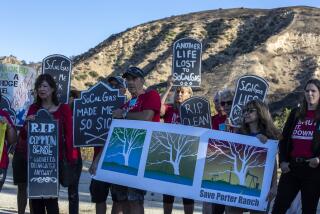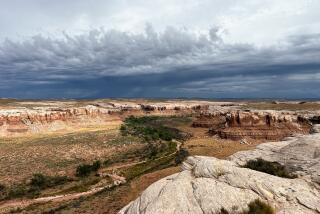‘Bulldozing’ One of the World’s Treasures : Grand Canyon: While the impact of Glen Canyon Dam water releases is under review, Secretary Lujan should curb the flows and keep the canyon floor from washing away.
- Share via
This Tuesday in Los Angeles and on Wednesday in San Francisco, the Department of the Interior will solicit the public’s view on whether it should protect one of the world’s most revered natural treasures or literally allow it to wash away.
In a three-week series of forums that began this month in Salt Lake City, the department is taking testimony on establishing the scope of a study on the environmental impact of the Glen Canyon Dam on the famed Grand Canyon National Park, just a few miles downstream.
Each day, the federal Bureau of Reclamation releases a wall of water from Lake Powell, the reservoir of Colorado River water backed up by the Glen Canyon Dam. As this water falls through the dam’s giant turbines, it generates “peaking” electric power demanded by utilities in the Southwest. Later in the day, as the demand for electricity diminishes, the flows are reduced to a trickle.
These widely fluctuating water releases are washing away the once-pristine beaches along the canyon floor and causing other problems for endangered species and recreational users in Grand Canyon National Park.
The Grand Canyon is clearly a wonder to people the world over. Dramatic canyon walls, reaching a height of more than 7,000 feet, provide unequaled vistas on the American landscape. The United Nations has selected the Grand Canyon as a World Heritage Site, one of only 12 natural areas in the United States to be so honored. The canyon is also an economic magnet for the Southwest. It attracts millions of people from all over the world each year, including thousands who float downriver in rafts, kayaks and wooden dories.
It took the Colorado River 40 million years to carve the canyon. But in just a few years the Bureau of Reclamation tamed the mighty Colorado with huge dams and literally corralled the Grand Canyon between Hoover Dam and Glen Canyon Dam.
Despite the historical and natural attractions of the Grand Canyon, a Department of the Interior study issued last year found that the Bureau of Reclamation’s operation of Glen Canyon Dam was having “substantial adverse effects on downstream resources,” including the Grand Canyon. It might as well be running hundreds of bulldozers down the canyon floor daily.
By launching the comprehensive environmental impact study eight months ago, Interior Secretary Manuel Lujan Jr. has taken an important first step in recognizing that his department (along with the Department of Energy) has been the source of the problems affecting the Grand Canyon. The public meetings like the ones in Los Angeles and San Francisco this week are designed to establish the scope of the study, which will supposedly determine options for correcting the problems in the canyon and make scientifically credible recommendations to Lujan.
Unfortunately, this step is too little, too late. The timetable is ambitious but everyone expects a final solution to be tied up by procedural and court challenges once the final results are published. And indications are that entrenched water and power development interests are once again teaming up in an effort to stifle an objective study. The ultimate resolution to this controversy could take years.
Meanwhile, the destruction of the canyon will continue. The Interior Department admits that this destruction does not have to occur and that there is an alternative. Modifying the present operation of Glen Canyon Dam could smooth out the wildly fluctuating flows and prevent the bottom of the canyon from washing away.
This approach does have a price. It would reduce the amount of hydroelectric power produced at Glen Canyon Dam. Some experts estimate the effect will be minimal; the utilities that sell the power say the impact would be significant.
There is more that Lujan can--and should--do. While the environmental review is proceeding, he should operate Glen Canyon Dam in a way that protects the resources of the Grand Canyon. After all, the canyon belongs to all Americans. Continuing its destruction to satisfy the needs of a few electric power companies is a far cry from Secretary Lujan’s commitment to stewardship.
Some people say Lujan’s choice on this issue will be tough. I disagree.
The choice is clear. Preserve and protect the Grand Canyon, Mr. Secretary. Don’t continue its desecration.
More to Read
Sign up for Essential California
The most important California stories and recommendations in your inbox every morning.
You may occasionally receive promotional content from the Los Angeles Times.










